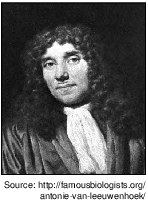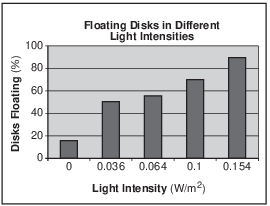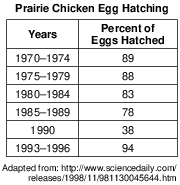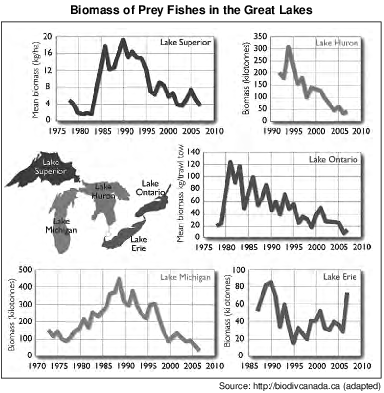Topic: Observations Inquiries Inferences
Observations Inquiries Inferences
Using microscopes he constructed in the 1600s, Antonie van Leeuwenhoek discovered a new microscopic world. His discoveries paved the way for the development of the microscopes used today and for many important biological breakthroughs.

Which statement best describes van Leeuwenhoek’s work?
(1) His observations alone provided enough information to form modern biological theories.
(2) The microscopes he made were used by all scientists and have remained unchanged over the years.
(3) Knowledge gained by his work has led to the improvement and development of modern scientific concepts.
(4) Explanations of the microscopic world today are solely based on his observations and conclusions.
Small disks were cut from spinach leaves that had been treated to remove any air from inside the leaf. The disks were placed in a solution that allowed them to carry out photosynthesis. At first, all the disks sank to the bottom of the container. These disks were then used for two different investigations.
Investigation 1
The disks were divided into five groups. Each group was exposed to light of a different intensity, measured in watts per meter squared (W/m2). Some of the disks began to float. The results of the first investigation are shown in the graph below.

The substance produced inside the leaf disks that caused them to float to the surface of the solution is
(1) ozone
(2) oxygen
(3) water
(4) nitrogen
Illinois Greater Prairie Chicken on the Rise
As pioneers moved west in the mid-1800s, the greater prairie chicken population in Illinois was estimated to number in the millions. Since then, their population has drastically declined.
Evidence of the rapidly declining population was obtained from studying the number of eggs that hatched over several years. In Jasper County, Illinois, the number of prairie chickens fell from 2,000 to less than 50 in under 35 years. Researchers compared the DNA from feather samples from the living Illinois chickens to the DNA from feather samples dating from the year 1930 found in a museum. It was found that the living Illinois chicken population had a very low level of genetic diversity.
In 1992, researchers attempted to increase genetic variation by transporting more than 500 healthy prairie chickens into Illinois from the states of Minnesota, Kansas, and Nebraska. The data table below shows the changes in the percent of eggs that hatched from samples taken in different years. Researchers documented that this increase in the percent of eggs that hatched was not influenced by environmental events.

Directions: Using the information given, construct a bar graph on the grid following the directions below.
The scientists transported prairie chickens from three different states into the state of Illinois in order to
(1) decrease egg hatching rate
(2) increase genetic diversity
(3) increase egg fertilization
(4) develop different feather colors
In the early 1600s, a scientist planted a willow tree that weighed 5 pounds in 200 pounds of dry soil. He placed it outside and watered it for 5 years. At the end of that time, he observed that the tree had gained 164 pounds 3 ounces, while the soil had lost just 2 ounces.

From this, he concluded that plants gain weight from the water they take in. His conclusion was based on
(1) the input of scientists from many countries doing similar studies
(2) the application of advanced technologies to the study of a problem
(3) careful observation, measurements, and inferences from his data
(4) an extensive knowledge of the process of photosynthesis
The chart below provides information about two scientific discoveries in the field of biology.

Which statement is the best interpretation of the material presented in the chart?
(1) Scientific explanations are built by combining evidence that can be observed with what people already know.
(2) Inquiry involves making judgments about the reliability of the source and relevance of the information.
(3) Science provides information, but values are also essential to making ethical decisions.
(4) Hypotheses are valuable even if they turn out not to be true, because they may lead to further investigation.
Hydrogen peroxide (H2O2) is a toxic compound that is produced by plant and animal cells. These cells also produce the enzyme catalase, which converts H2O2 into water and oxygen gas, preventing the buildup of H2O2.
A student designed an experiment to test the effect of an acidic pH on the rate of the reaction of H2O2 with catalase. The data below summarize the outcome of the experiment.

Which graph most accurately represents the results obtained by this student?
(1) 
(2) 
(3) 
(4) 
Before conducting an experiment, two students gathered information about the effect of greenhouse gases on global warming. Student A found information in a newspaper article. Student B found information in several peer-reviewed scientific journals and on three websites.
Which statement most likely describes the reliability of the students’ information?
(1) Information gathered by student A is more reliable because newspapers are always updated to reflect the most current research.
(2) Information gathered by student B is more reliable because some of it was gathered from peer-reviewed sources.
(3) Information gathered by student A is more reliable because it is from a single source without conflicting information.
(4) Information gathered by student B is more reliable because some of it was found on the internet.
Green Tea & Acne
Green tea might be an effective treatment for acne, according to a study by researchers from Memorial Medical Center in the Philippines, reported by United Press International (UPI). The study showed that 3 percent green tea cream is comparable to 4 percent benzoyl peroxide in the treatment of moderate to severe acne.
Green tea has been shown to fight bacteria, reduce inflammation and decrease hormone activity — three characteristics that make the ancient tea an excellent candidate for an acne therapy.
In the study, one group of subjects applied benzoyl peroxide cream twice daily for 12 weeks and another used green tea extract cream twice daily for the same period. Patients received identical bottles of cream and were unaware of the type of treatment they were assigned. The researchers noted the green tea cream seemed to lighten patients’ [acne] and improve the overall appearance of their complexion.
The preliminary data suggest green tea extract cream causes fewer side effects than benzoyl peroxide treatment. Patients in the green tea group reported fewer cases of dry skin, itching and allergic responses. Azucena Arguelles, MD, a private practice dermatologist from Mountain View, CA, told UPI that the findings, while promising, are not yet substantial enough to change clinical practice.
Advance for Nurses, Nov. 10, 2003, “Green Tea & Acne,” www.advanceweb.com
Explain how this experiment can be used to develop a new treatment for acne. In your answer, be sure to:
• identify the organism targeted by green tea [1]
• identify one advantage of using green tea extract instead of benzoyl peroxide cream to treat acne [1]
• state one reason why, even though the findings are promising, they are “not yet substantial enough to change clinical practice” [1]
The student’s response to the bulleted items in the question need not appear in the following order.
• 8 Allow 1 credit for identifying the organism targeted by green tea. Acceptable responses include, but are not limited to:
• — bacteria
• — acne
• — C. acnes
• — Propionibacterium acnes
• 9 Allow 1 credit for identifying one advantage of using green tea extract instead of benzoyl peroxide cream to treat acne. Acceptable responses include, but are not limited to:
• — causes fewer side effects
• — less itching
• — lightening of acne on the skin
• — improved overall complexion
• 10 Allow 1 credit for stating one reason why, even though the findings are promising, they are “not yet substantial enough to change clinical practice.” Acceptable responses include, but are not limited to:
• — need to repeat experiment to see if results are the same
• — need a larger sample group
• — need to see if side effects occur later on
Transgenic Salmon
Transgenic Atlantic salmon have been produced using DNA from other species of related fish. These genetically modified fish have an altered DNA “switch” that causes them to overproduce growth hormone. The transgenic Atlantic salmon grow to normal size, but they reach market size in half the time of conventional Atlantic salmon. As with most of the salmon consumed by people, the transgenic Atlantic salmon would be grown using aquatic farming methods. Scientists have expressed concern that transgenic fish can have undesirable effects on the natural environment. Fish growers would be expected to take steps to ensure that the transgenic salmon do not escape into the wild.
State one benefit of raising the transgenic Atlantic salmon. [1]
Allow 1 credit. Acceptable responses include, but are not limited to:
• — The transgenic Atlantic salmon grow faster.
• — Salmon farming could be more profitable.
• — Transgenic salmon can be brought to market sooner, so people would have more food.
• — Farming transgenic salmon could help conserve the wild salmon populations.
Invasive species have damaged agricultural crops all over the world. One study, completed in Japan, calculated the number of invasive insect species present in Japan from 1880 to 1990. Some of the data are recorded in the table below.

Directions: Using the information in the data table, construct a line graph on the grid provided, following the directions below.
State one reason why invasive insect species are a major problem for agriculture. [1]
Allow 1 credit. Acceptable responses include, but are not limited to:
• — They have damaged crops all over the world.
• — They reduce the amount of food produced.
• — They might bring a new plant disease to an area.
• — There are no predators present to control the invasive population.
• — They ruin crops; they make them unattractive and not able to sell.
The line graphs below represent trends in prey fish populations for each of the five Great Lakes.

Identify in which of the Great Lakes you would expect to see the greatest increase in the number of predatory fish in 2008 and 2009. Support your answer. [1]
Allow 1 credit for identifying Lake Erie and supporting the answer. Acceptable responses include, but are not limited to:
• — The prey fish population increased between 2005 and 2007. There would be more food for predatory fish to consume in 2008 and 2009.
• — In all of the lakes but Lake Erie, the population of prey fish has decreased.
• — Lake Erie has the only population of prey fish that has increased over the past few years.
Artificial Placenta
It is estimated that every year more than 15 million babies are born too early. The lungs of these premature infants are often immature and easily damaged. Premature births happen for a variety of reasons—some known and some unknown. Those that are known include infections and conditions such as diabetes and high blood pressure. Scientists are researching what causes premature births, in an attempt to develop solutions to prevent them.
Scientists are also working on the development of an artificial placenta. At the University of Michigan, five premature lambs were placed in artificial placentas and kept alive for weeks. During this time, each lamb’s blood was circulated through its artificial placenta.
Discuss how the development of an artificial placenta is an important step in the study of premature births. In your answer, be sure to:
• explain why it would be harmful for a human mother’s blood to pass across the placenta and into the
fetus [1]
• state how an artificial placenta would be of benefit to the lungs of premature infants [1]
• explain why the lambs’ blood must be filtered as it circulates through the artificial placenta [1]
• state one reason why premature lambs were likely used as model organisms in this study rather than
mice [1]
The student’s response to the bulleted items in the question need not appear in the following order.
• 14 Allow 1 credit for stating why it would be harmful for a human mother’s blood to pass across the
• placenta and into the fetus. Acceptable responses include, but are not limited to:
• — The mother’s blood may be interpreted as a pathogen and attacked by the fetus’s immune
• system.
• — The mother’s blood could contain chemicals and pathogens that could harm the fetus.
• — It could cause an immune response.
• — It could be a different blood type that could cause a reaction.
• — It could harm the fetus’s organs.
• 15 Allow 1 credit for describing how an artificial placenta would be of benefit to the lungs of
• premature infants. Acceptable responses include, but are not limited to:
• — The lungs would be able to continue to mature, and the premature infant would not have
• to breathe on its own too soon.
• — The artificial placenta would perform the same processes as the natural placenta, allowing
• the lungs to continue to develop.
• — The artificial placenta would supply oxygen until lungs developed.
• — It would be of benefit because it prevents the accumulation of carbon dioxide.
• — It would help lessen complications associated with the mother’s high blood pressure/
• diabetes.
• 16 Allow 1 credit for explaining why the lambs’ blood must be filtered as it circulates through the
• artificial placenta. Acceptable responses include, but are not limited to:
• — The blood contains waste products that need to be removed.
• — Filtering removes wastes from the blood.
• 17 Allow 1 credit for discussing why premature lambs were likely used as model organisms in this
• study rather than mice. Acceptable responses include, but are not limited to:
• — Lambs are larger and more similar to human fetuses than mice are.
• — The development of a premature lamb is more similar to that of a human.
Scientists have been experimenting with different forms of alternate energy to help reduce the amount of fossil fuels that are burned. They studied yeast, which convert plant materials into ethanol, a form of alcohol that can be used in automobiles. These experi- ments were carried out at room temperature. The scientists wondered whether more ethanol would be produced at different temperatures.
Design an experiment to determine the effect of temperature on ethanol production by yeast. In your answer, be sure to:
• state one hypothesis the experiment would test [1]
• state how the control group would be treated differently from the experimental group [1]
• identify two factors that must be kept the same in both the experimental and control groups [1]
• identify the independent variable in the experiment [1]
The student’s response to the bulleted items in the question need not appear in the following order.
• 18 Allow 1 credit for stating one hypothesis the experiment would test. Acceptable responses include,
• but are not limited to:
• — Increasing the temperature will increase the rate of ethanol production.
• — Decreasing the temperature will increase the rate of ethanol production.
• — Temperature affects the rate of ethanol production.
• Note: Do not allow credit for a hypothesis written in the form of a question.
• 19 Allow 1 credit for stating how the control group would be treated differently from the experi-
• mental group. Acceptable responses include, but are not limited to:
• — The control group will be kept at room temperature, while the experimental group will be
• kept at a higher/lower temperature.
• — The control group would be kept at room temperature.
• Note: Allow credit for an answer consistent with the student’s hypothesis for question 61.
• 20 Allow 1 credit for identifying two factors that must be kept the same in both the experimental and
• control groups. Acceptable responses include, but are not limited to:
• — amount of yeast used
• — amount of plant material used
• — type of plant material used
• — species of yeast used
• Note: Allow credit for an answer consistent with the student’s hypothesis for question 61.
• 21 Allow 1 credit for identifying the independent variable in the experiment as temperature.
• Note: Allow credit for an answer consistent with the student’s hypothesis for question 61.
Indian blue peacocks live in dense forests and scrubland. Males use their colorful eye-spotted tail feathers and strutting display along with a loud mating call to attract females. This behavior, known as a hoot-dash, is made by the male before dashing toward a female to mate. Few species of other animals use loud courtship calls as the call attracts predators and uses energy.
Discuss the use of the hoot-dash by male peacocks. In your answer, be sure to:
• state one advantage of the hoot-dash [1]
• state one disadvantage of the hoot-dash [1]
The student’s response to the bulleted items in the question need not appear in the following order.
• 22 Allow 1 credit for stating one advantage of the hoot-dash. Acceptable responses include, but are
• not limited to:
• — The hoot-dash helps to locate a mate.
• — The hoot-dash attracts a mate.
• — It increases chances of reproduction.
• 23 Allow 1 credit for stating one disadvantage of the hoot-dash. Acceptable responses include, but are
• not limited to:
• — The hoot-dash can attract predators.
• — The male may be heard and be eaten by a predator.
• — The call uses energy.
In a laboratory, spinach leaves exposed to continuous fluorescent light increased in vitamin content by 50 to 100 percent. Spinach leaves kept in darkness for a similar period of time either lost vitamin content or produced no gain. Describe how these findings could influence the way in which spinach is displayed for sale in supermarkets. [1]
Allow 1 credit. Acceptable responses include, but are not limited to:
• — Spinach should be displayed under fluorescent lights.
• — Spinach should be displayed in transparent packaging, under lighted conditions.
• — Spinach should not be sold in containers that block light.
